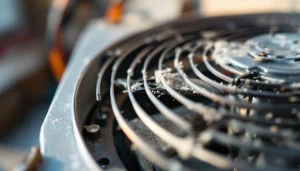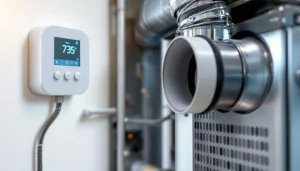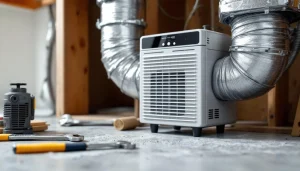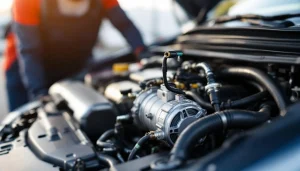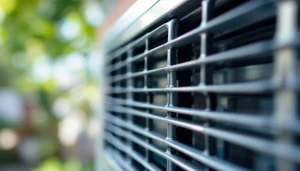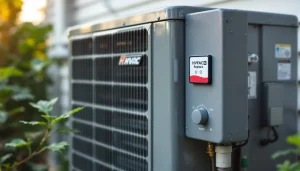Building a new home? The HVAC system is a critical component you can’t overlook. At Klein Cooling, we understand the complexities of residential new construction HVAC and its impact on your home’s comfort and efficiency.
In this post, we’ll guide you through the essential aspects of choosing, installing, and optimizing HVAC systems for new homes. We’ll cover everything from system types to energy efficiency considerations, helping you make informed decisions for your construction project.
How to Choose the Perfect HVAC System for Your New Home
Assessing Your Home’s Unique Needs
The selection of the right HVAC system starts with an evaluation of your specific requirements. Your home’s square footage, the local climate in Palm Coast, FL, and your family’s comfort preferences all play a role. A 2,000 square foot home in our humid subtropical climate will have different needs than a similar-sized home in a cooler region.
Exploring HVAC System Types
Central air conditioning systems are popular in new constructions, especially in warm climates. They cool large spaces effectively and can pair with a furnace for heating. However, they require ductwork, which impacts your home’s design.
Heat pumps have become more popular due to their energy efficiency. They both heat and cool your home, making them versatile for Florida’s climate. The U.S. Department of Energy reports that heat pumps can reduce electricity use for heating by approximately 50% compared to electric resistance heating.

Ductless mini-splits offer flexibility for zoned cooling and heating. They excel in additions or areas where ductwork isn’t feasible. While the upfront cost is higher, they can result in significant energy savings over time.
The Importance of Proper Sizing
Incorrect sizing is a common mistake in new construction HVAC installation. An oversized system will cycle on and off frequently, which leads to increased wear and tear and higher energy bills. Undersized systems struggle to maintain comfort and run constantly, also increasing energy consumption.
To avoid these issues, HVAC professionals should perform detailed load calculations using industry-standard methods like Manual J. This process takes into account factors such as your home’s orientation, window placement, insulation levels, and even the number of occupants to determine the exact capacity needed.
Energy Efficiency Considerations
When you select your system, pay close attention to efficiency ratings. For air conditioners and heat pumps, look for a high Seasonal Energy Efficiency Ratio (SEER). As of 2023, the minimum SEER rating for new installations in Florida is 15, but higher ratings can lead to greater energy savings.
High-efficiency systems may have a higher upfront cost, but they can lead to substantial savings over the life of the system. ENERGY STAR considers up-front costs and lifetime energy savings when setting required efficiency levels for certified products.
Professional Guidance
The selection of an HVAC system for a new home involves many factors. Professional guidance can help you navigate these choices. Experienced HVAC contractors (like those at Klein Cooling) can provide valuable insights based on local climate conditions and building practices.
As we move forward to discuss the HVAC installation process, it’s important to understand how your system choice will impact the construction timeline and overall home design.
How HVAC Installation Works in New Home Construction
The Importance of Timing
HVAC installation is a key phase in new home construction that requires precise planning and coordination. The process typically starts during the “rough-in” stage, after framing completion but before drywall installation. This timing allows easy access for ductwork, electrical connections, and refrigerant line installation. The National Association of Home Builders reports that new refrigerants and HVAC regulations may impact installation timelines and product availability in the coming years.
Ductwork: The HVAC System’s Foundation
Proper ductwork installation is essential for system efficiency. The Air Conditioning Contractors of America (ACCA) recommends sizing ductwork according to Manual D calculations to ensure optimal airflow. ACCA’s Manual Q provides guidance for low pressure, low-velocity duct system design in small to mid-size commercial buildings.
During installation, we minimize bends and turns, which can restrict airflow. We also ensure proper insulation, especially in unconditioned spaces like attics, to prevent energy loss. The U.S. Department of Energy states that well-insulated and sealed ducts in unconditioned spaces can improve heating and cooling system efficiency by about 20%.

Strategic Equipment Placement
The location of HVAC equipment significantly impacts its performance and home comfort. For outdoor units, we consider factors like shade, drainage, and maintenance accessibility. We typically place indoor units in areas with minimal foot traffic (such as utility rooms or attics).
Proper ventilation is essential. We ensure outdoor units have adequate clearance – typically 24 inches on all sides – to maintain airflow and efficiency. For indoor units, we install proper ventilation systems to prevent issues like carbon monoxide buildup, adhering to local building codes and manufacturer specifications.
Quality Control and Testing
Before drywall installation, we conduct thorough testing of the HVAC system. This includes pressure testing ductwork for leaks and verifying secure connections. The Environmental Protection Agency (EPA) reports that leaky ducts can reduce heating and cooling system efficiency by as much as 20%.
We also perform a full system startup and calibration once the home nears completion. This final check ensures that the HVAC system operates at peak efficiency from day one.
The HVAC installation process requires expertise and attention to detail. Working with licensed professionals who understand local building codes ensures correct system installation for optimal performance and longevity. As we move forward, let’s explore how energy efficiency and building codes play a role in new construction HVAC systems.
How Efficient HVAC Systems Meet Building Codes
Understanding SEER Ratings
SEER (Seasonal Energy Efficiency Ratio) ratings measure air conditioner and heat pump efficiency. Higher SEER ratings indicate greater efficiency. SEER represents how much energy and money the unit requires to cool effectively over a single year. We recommend systems with higher SEER ratings for optimal energy savings.
ENERGY STAR certified HVAC systems exceed these minimum requirements. They must be at least 15% more efficient than standard models. These systems can lead to significant energy savings over time (the EPA estimates up to 20% on annual cooling costs), despite higher upfront costs.

Local Building Code Compliance
Building codes in Palm Coast, FL, and surrounding areas ensure safety and efficiency in HVAC installations. These codes cover equipment placement, ventilation requirements, and energy efficiency standards.
Florida’s building code requires HVAC systems to be sized according to Manual J load calculations. This allows professionals to accurately size an HVAC unit, improving energy efficiency, reducing operational costs, and ensuring long-term performance.
Local codes also mandate proper insulation of ductwork in unconditioned spaces. This requirement prevents energy loss and improves overall system efficiency. The International Energy Conservation Code (IECC), which Florida follows, specifies minimum R-values for duct insulation based on home location.
Benefits of High-Efficiency Systems
High-efficiency HVAC systems in new construction offer long-term advantages. These systems reduce energy bills, provide superior comfort, and often have longer lifespans.
A National Renewable Energy Laboratory study found that high-efficiency air conditioners can reduce cooling energy use by 20-50% compared to conventional models. This translates to substantial savings over the system’s life.
Efficient systems often include advanced features like variable-speed compressors and smart thermostats. These technologies allow more precise temperature control and adapt to changing conditions, enhancing comfort and efficiency.
Future-Proofing HVAC Investments
HVAC system installation in new construction should consider future regulations and technological advancements. The industry moves towards more environmentally friendly refrigerants and stricter efficiency standards.
The EPA’s AIM Act mandates a phasedown of high-global warming potential refrigerants. Homeowners can avoid potential costly upgrades by choosing a system compatible with newer, low-GWP refrigerants.
We stay ahead of these trends to provide HVAC solutions that meet current standards and prepare for future changes. Our focus on energy-efficient, code-compliant systems equips new construction projects in Palm Coast, FL, with HVAC systems that offer long-term value and performance.
Final Thoughts
Residential new construction HVAC systems play a vital role in creating comfortable and efficient homes. Professional installation ensures proper sizing, strategic equipment placement, and meticulous ductwork installation for optimal system performance. These factors, combined with adherence to local building codes and energy efficiency standards, establish the foundation for a reliable HVAC system.
Quality HVAC systems in new construction projects offer significant long-term benefits. Energy-efficient systems reduce utility bills, provide superior comfort, and often have longer lifespans. Systems with high SEER ratings and ENERGY STAR certification allow homeowners to enjoy lower operating costs and reduced environmental impact.
We at Klein Cooling understand the complexities of residential new construction HVAC. Our team provides tailored solutions that meet the unique needs of each home in Palm Coast, FL, and surrounding areas. We prioritize energy efficiency, code compliance, and customer satisfaction in every installation (while always adhering to local regulations).

